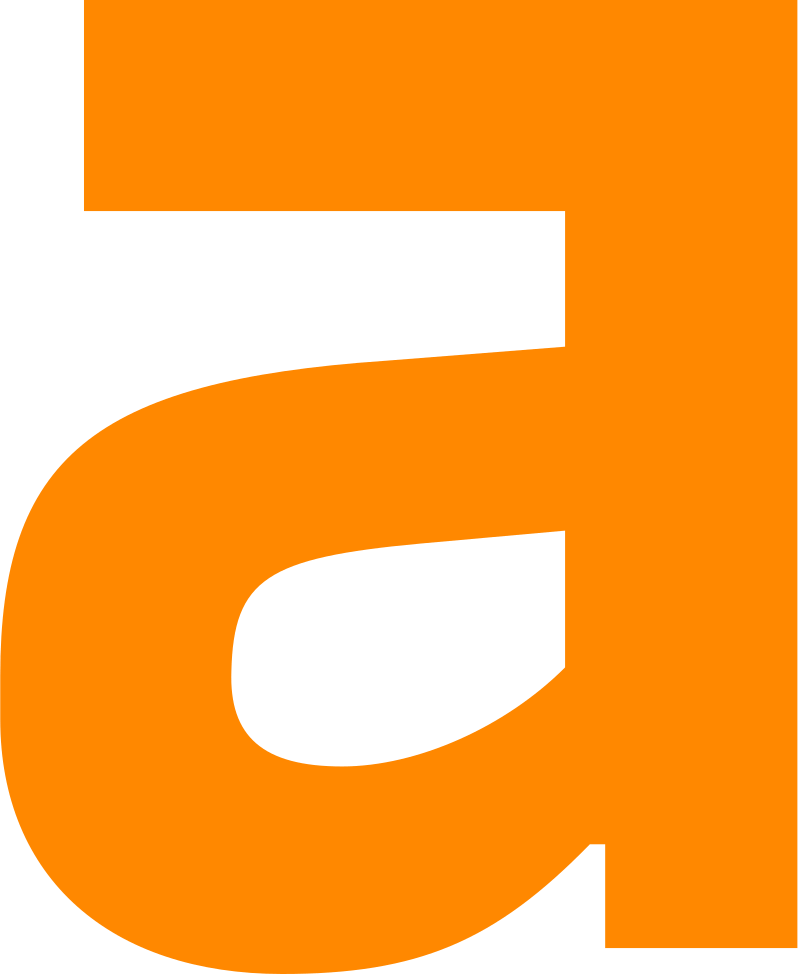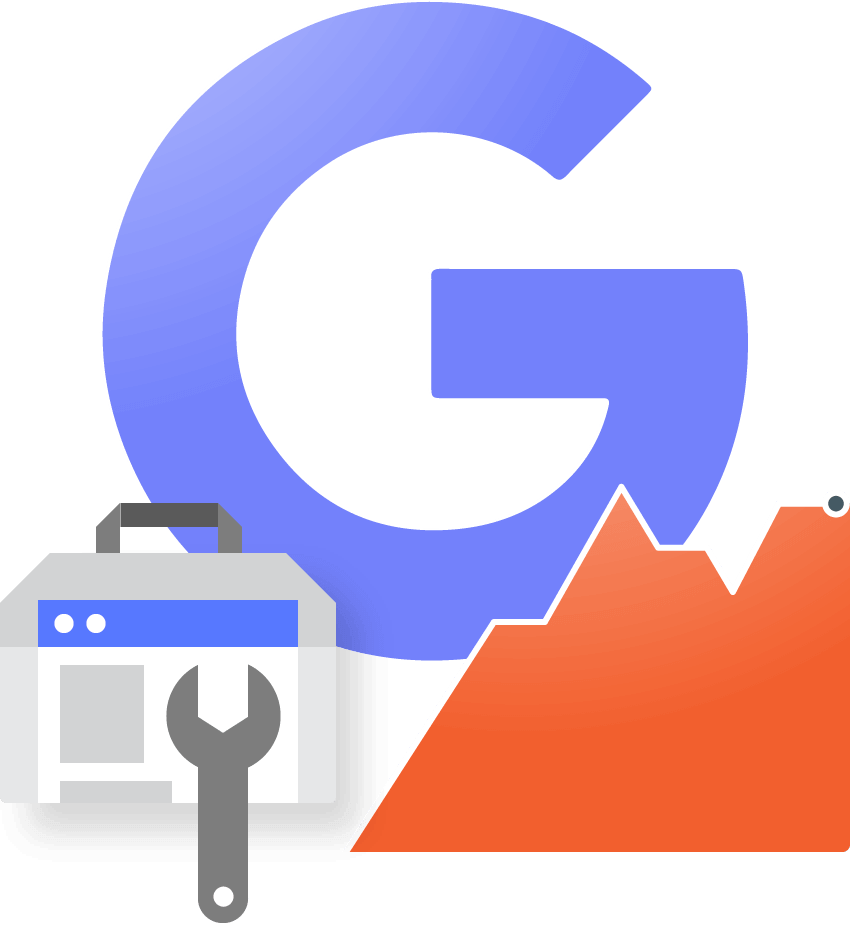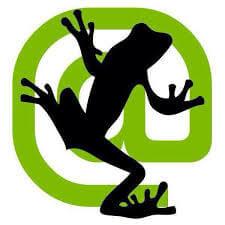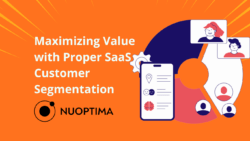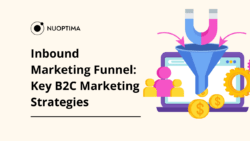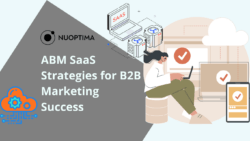Suppose SaaS product marketing is your job, and you’re one of the 56% of product marketers with revenue generation as their main responsibility and OKR [1]. In that case, you’ve come to the right place to learn proven and innovative strategies for exceeding it.
It gets even more complicated if you’re working in B2B SaaS product marketing, as B2B buyers conduct, on average, 12 searches before clicking on any specific brand’s website.[2]. You really need to learn how to attract attention to your SaaS product and keep it.
To help you succeed, we’re covering everything, from how effective SaaS product marketing plan increases sales, top strategies to do it, and how to create your own – all accompanied by top-notch examples from the most successful SaaS companies.
What Is SaaS Product Marketing?
At its core, SaaS product marketing is about understanding the market and the specific needs of your target audience. You need to do extensive research to identify your buyer personas, understand their pain points, and determine how your product provides solutions.
Once you figure this out, you have to implement your findings in your messaging and campaigns across all marketing channels. Incorporating a well-defined GTM strategy is crucial for aligning your marketing efforts with your sales and product development teams, ensuring a unified approach to reaching your market.
How Effective SaaS Product Marketing Plan Increases Sales
Every year, entrepreneurs and wannabe entrepreneurs launch more than 30,000 new products, and 95% of those fail. [3] Chances are, if they knew more about product marketing before launching, they’d know how effective it can be in driving sales.
Luckily for you, you’re right where you need to be. By crafting a strategic SaaS product marketing plan, you’ll directly experience:
- How targeted product marketing campaigns will help you identify and attract potential customers who will most likely benefit from your product. You’ll use insights and data from these campaigns to increase your customer base and reach the right audience with the right message.
- How SaaS product marketing strategy influences acquisition and contributes to retention. With proven strategies, you’ll create an unparalleled customer experience and focus on building long-term relationships instead of one-off transactions. Your customers will always get value from you with personalized communication and support, leading to repeat purchases and subscriptions.
- How product marketing works like a charm when it comes to identifying upselling and cross-selling opportunities and capitalizing on them. You’ll understand customer needs and behaviors, and equipped with that knowledge, selling additional features, upgrades, or complementary products will be easier and will increase your average revenue per user (ARPU).
- How you’ll become a thought leader in your industry and build brand recognition and authority with consistent and strategic SaaS product marketing efforts. This creates an avalanche of referrals and new loyal customers will come pouring in.
- How to reduce churn rate to a minimum and eliminate its influence on your revenue. Product marketing also addresses the issue of engaging your customers throughout their lifecycle and provides them with the resources they need to achieve success with your product. You’ll open the door to stable revenue and sustainable growth.
Top SaaS Product Marketing Strategies
To drive significant sales growth and achieve measurable business outcomes, you need to know right from the start which SaaS product marketing strategies will work for your business. Having worked with hundreds of SaaS companies like yours, here are the strategies that have the highest ROI:
Content Marketing
SaaS content marketing is one of the best choices for product marketing. When you create valuable and informative content, such as blogs, whitepapers, case studies and webinars, it will attract your target audience like a magnet. But high-quality content also establishes your brand and product as the best in the industry.
Example
HubSpot’s extensive library of free marketing resources has been instrumental in attracting and converting leads.

Tools:
- WordPress for content
- Canva for creating visual content
- WebinarJam SaaS product marketing platform for hosting webinars
SEO
Optimizing your website and content for search engines is absolutely essential to increasing organic traffic and getting high-quality leads with SEO. By targeting relevant keywords across buyer journey stages, you will build topical authority, increase your rankings, and boost organic search conversions.
But before doing all that SEO work, you have to make sure that your website satisfies SaaS technical SEO needs so search engines can crawl and index your pages. Understanding the differences between technical SEO vs content SEO is crucial because both are fundamental to a successful strategy.
- Optimize your website’s speed. Use the free PageSpeed Insights [4] tool and aim for a score of 75 and above.
- Make sure that you have a high score on both mobile and desktop and that your website is responsive.
- Get rid of broken links to improve your crawlability.
- Create and submit an XML sitemap to guide search engines in discovering and ranking your pages.
- Use a robots.txt file to control which pages search engines should or shouldn’t crawl.
- Secure your site with an SSL certificate to protect user data and improve rankings.
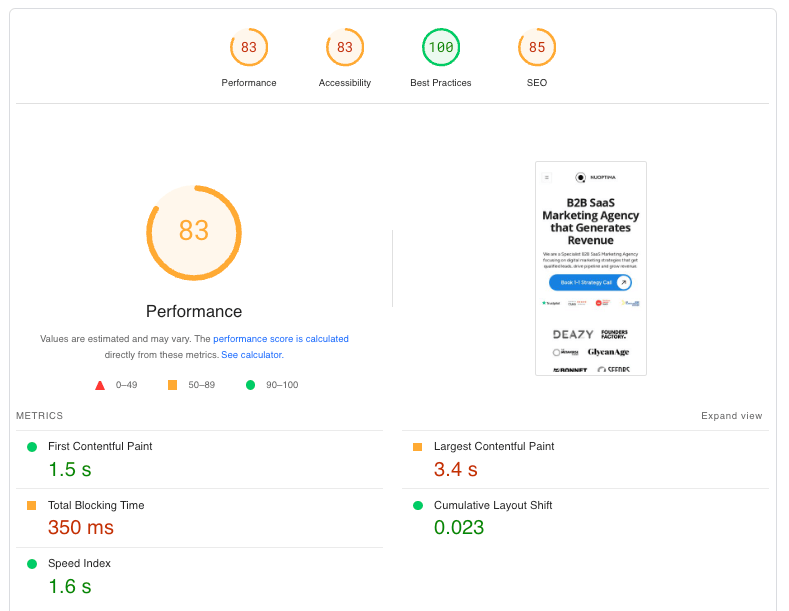
After you have a sound technical foundation, it’s time to roll up your sleeves and dig deep into keyword research. Your job here is to identify relevant keywords that your target audience is likely to use when searching for solutions your SaaS product offers. You also have to be mindful and optimize your content for all these types of keywords:
- Informational (What is X, How to X, etc.)
- Navigational (Best X Software)
- Transactional (Project Management Software)
Transactional keywords are the best fit for SaaS landing pages as that’s exactly what people who search for them expect to find.
Tools like Ahrefs, SEMrush, and Google Keyword Planner can help you find high-volume, low-competition keywords.
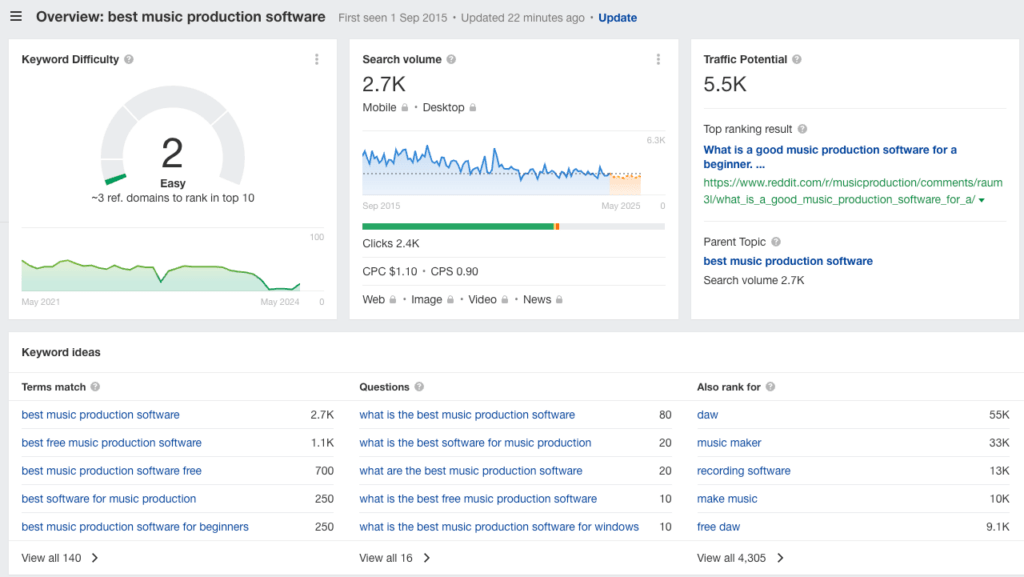
When you’ve done keyword research, it’s time to optimize individual pages and blog posts to rank higher and earn more relevant traffic. Here is the checklist for on-page SEO:
| Title Tags | Ensure your page titles include primary keywords and accurately describe the content. Example: Best Music Production Software in 2025 |
| Meta Descriptions | Write compelling meta descriptions that incorporate keywords and encourage clicks. Example: Are you in the music industry and looking for music production software? We researched the best music production software to help you decide which is right for you. |
| Header Tags | Use H1, H2, and H3 tags to structure your content and make it easier for search engines to understand. H1 Example: Best Music Production Software for Professional and Home Studios |
| URL Structure | Use clean and descriptive URLs that include relevant keywords Example: domain.com/best-music-production-software |
| Content Quality | Create high-quality, informative content that addresses the needs of your audience. Use keywords naturally throughout the content. |
| Internal Linking | Link to other relevant pages on your site to help search engines understand the structure and improve navigation for users. |
P.S. Don’t let the amount of SEO work you need to do overwhelm you; Nuoptima offers the best B2B SaaS SEO services that can increase your traffic up to 300% and more, as we did for our SaaS client, Zelt.
Tools
-
Ahrefs for keyword research and backlink analysis. -
Yoast SEO for on-page optimization. -
Google Analytics for tracking and analyzing traffic. -
Google Search Console for diving deeper into organic performance. -
PageSpeed Insights for technical SEO. -
Screaming Frog for deeper technical SEO analysis
Social Media Marketing
As a SaaS product marketing strategy tool, social media helps you engage with your audience build brand awareness, but also drive traffic and conversions.
The key is to choose the right social media platforms based on where your target audience spends their time. For SaaS companies, LinkedIn, Twitter, Facebook, and Instagram are often the most effective platforms. LinkedIn is particularly useful for B2B SaaS products due to its professional user base. Building a personal brand on LinkedIn can significantly enhance your professional reach and credibility. It’s also important to recognize the influence of dark social, where content is shared privately through direct messaging apps and emails, making it harder to track but equally valuable for brand engagement.
Once you’ve picked your channels, the possibilities are endless. You can create a variety of content types to keep your audience engaged. These can include:
| Videos | Use videos to showcase product features, share customer testimonials, or provide educational content. |
| Infographics | Create visually appealing infographics to present data and complex information in an easy-to-digest format. |
| Webinars and Live Streams | Host live webinars or Q&A sessions to engage with your audience in real-time. |
| User-Generated Content | Encourage your users to share their experiences and create content related to your product. |
| Blog Posts and Articles | Share links to your blog posts and articles that provide valuable insights and tips. |
But social media marketing isn’t a one-way street. You can create a real community and have a highly engaged audience if you:
- Actively respond to comments, mentions, and direct messages to show that you value your audience’s input and feedback.
- Join relevant industry discussions, answer questions, and provide insights in groups and forums.
- Run contests and giveaways to increase engagement and attract new followers.
Example
Buffer uses Twitter and LinkedIn to share tips, industry news, and product updates, engaging with their audience and positioning themselves as thought leaders in social media management.
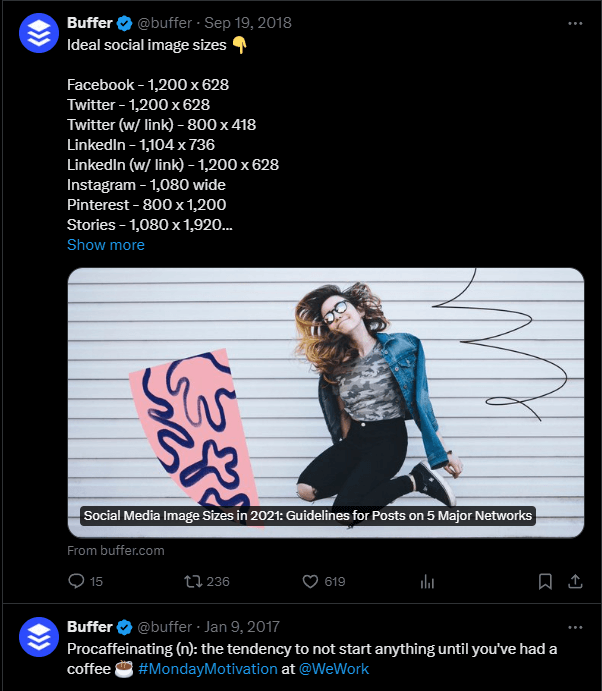
Tools
- Canva for designing graphics and infographics
- Animoto for creating videos
- BuzzSumo for content ideas and trend analysis
Email Marketing
Email marketing is a highly effective strategy for SaaS companies to nurture leads, retain customers, and drive conversions. How? You will have personalized communication with potential customers, which can significantly enhance their engagement. By partnering with a specialized SaaS email marketing agency, you can optimize your email campaigns for better results.
Building a high-quality email list is the first step. This involves collecting email addresses from interested prospects and customers through various methods:
| Lead Magnets | Offer valuable resources such as eBooks, whitepapers, or free trials in exchange for email addresses. |
| Sign-Up Forms | Place sign-up forms on your website, blog, and landing pages. Make sure they are easy to find and simple to fill out. |
| Webinars and Events | Collect emails from attendees of your webinars and live events. |
| Pop-Ups | Use exit-intent pop-ups to capture the attention of visitors who are about to leave your site. |
Segmenting your email list allows you to send targeted and relevant content to different groups of subscribers. Common segmentation criteria include:
| Demographics | Age, location, job title, industry, etc. |
| Behavior | Website activity, past purchases, email engagement, etc. |
| Customer Journey Stage | New leads, active customers, churned customers, etc. |
When it comes to the types of emails you can send to improve your SaaS product marketing strategy, these work the best and have the highest ROI:
- Welcome Emails
Introduce new subscribers to your brand and set expectations for future communications.
- Onboarding Sequences
Guide new users through the setup process and highlight key features of your product.
- Newsletters
Share company news, industry updates, and valuable content on a regular basis.
- Product Updates
Inform customers about new features, improvements, and upcoming releases.
- Promotional Offers
Send special offers, discounts, and incentives to encourage conversions.
- Re-Engagement Emails
Reach out to inactive subscribers with targeted content to win them back.
Example
HubSpot offers a range of free marketing tools that require users to provide their email addresses to access, effectively growing their email list.
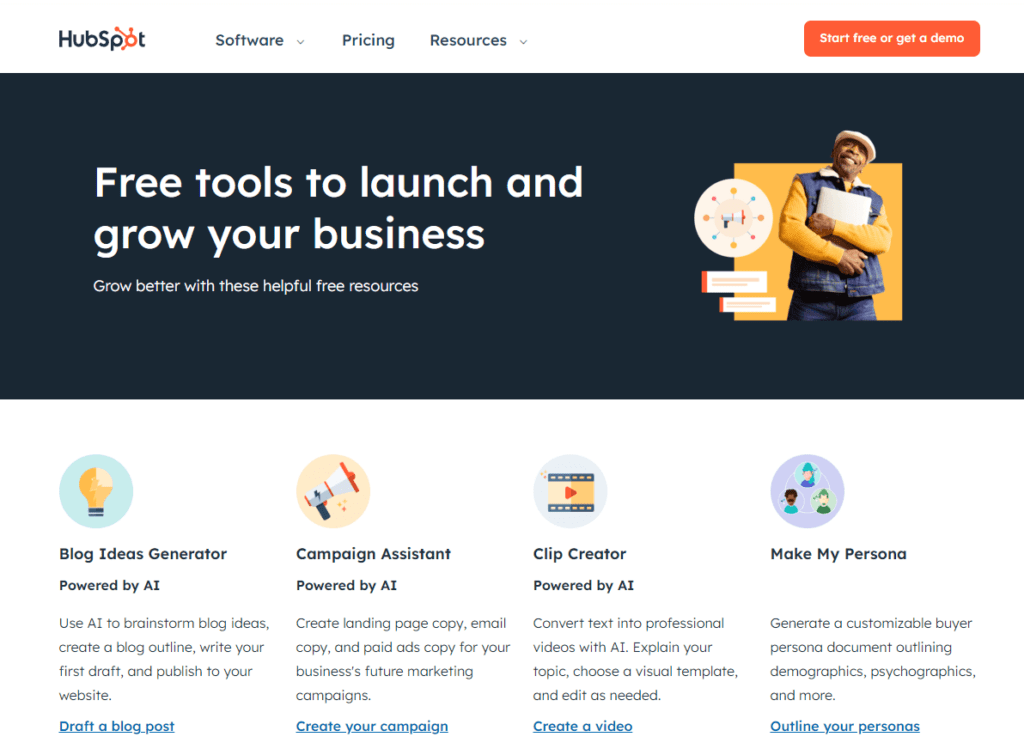
Tools
- OptinMonster for creating pop-ups and sign-up forms.
- Leadpages for designing landing pages and capturing leads.
- Klaviyo for advanced segmentation and automation.
- Optimizely for A/B testing and experimentation.
- Drip for behavior-based email automation.
Freemium Models and Free Trials
Freemium models and free trials are powerful B2B SaaS product marketing strategies for attracting users, demonstrating value, and converting them into paying customers. These approaches lower the barrier to entry, allowing potential customers to experience the product firsthand without any initial financial commitment.
But what’s in for you? You’ll:
- Attract a large number of users who might not commit to a paid plan initially.
- Reduce the risk for potential customers, making it easier for them to try the product.
- Get referrals from satisfied free users, contributing to organic growth.
However, you need to implement this strategy carefully to avoid problems like:
- Only a small percentage of free users convert to paying customers.
- Supporting a large number of free users is costly in terms of infrastructure and support.
If you want your freemium model to successfully increase your ARR, you need to clearly differentiate between free and premium features to highlight the added value customers get when they upgrade.
You can also use in-app notifications and emails to prompt free users to upgrade based on their usage patterns. After you get enough free users, you can implement limits on the free version (e.g., storage capacity, number of users) that encourage users to upgrade when they reach those limits.
When it comes to free trials, they are particularly effective for complex or high-value SaaS products. You allow users to explore all features and understand your product’s value. This leads to higher conversion rates as people who see the full potential of your product firsthand are more likely to become paying customers.
Example
Dropbox offers 2 GB of free storage with options to upgrade to paid plans for more storage and additional features. This model has helped Dropbox build a massive user base, many of whom eventually upgrade to paid plans.
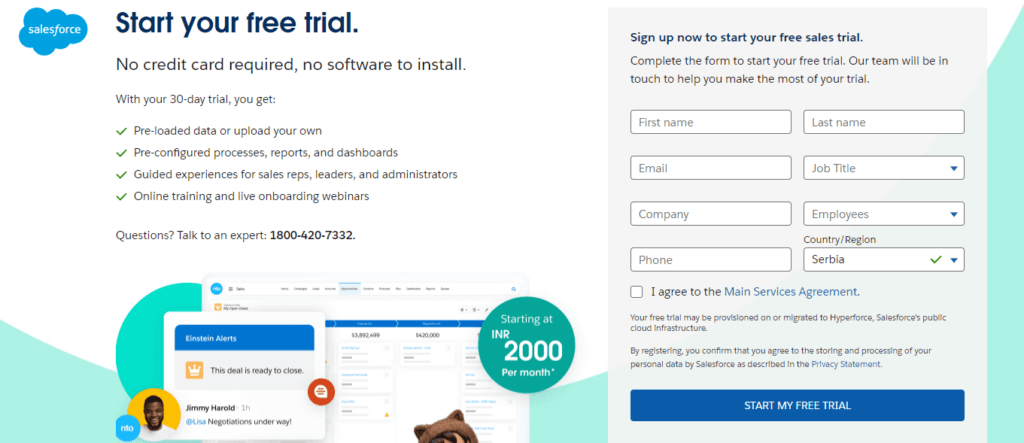
Salesforce offers a 30-day free trial of its CRM platform, providing access to all features. This allows potential customers to fully explore the product and see how it fits their needs before purchasing.
Tools
- Google Analytics for tracking user behavior and engagement.
- Mixpanel as a SaaS product marketing platform for detailed user analytics and segmentation.
- Intercom for in-app messaging and user engagement.
To gain further insights on ROI strategies, listen to an engaging conversation in the Nuoptima SaaS Podcast featuring Deepak Prabhakara from BoxyHQ
How to Create a SaaS Product Marketing Plan
To create a successful SaaS product marketing plan, you need detailed instructions that will help you guide your efforts toward your goals. With our step-by-step guide, you’ll create the most effective SaaS marketing plan:
Identify Your Target Audience
If you want your message to resonate with the right audience, you need to develop a comprehensive understanding of that audience. Your buyer personas need to consist of demographics, pain points, goals, and purchasing behaviors. Once you nail it, all of your campaigns will resonate with your audience, helping you convert bystanders into loyal customers.
Example: A buyer persona for a project management SaaS product could be a marketing manager who is a 35-year-old and struggles with lack of productivity and organization in their team’s workflow.
Conduct a Competitive Analysis
Analyze your competitors to understand their strengths, weaknesses, and marketing strategies. Identify gaps in the market that you can exploit and learn from their successes and mistakes. Tools like SEMrush and Ahrefs can help you perform a thorough competitive analysis.
Example: Discover that your main competitor is heavily investing in content and SaaS affiliate marketing but lacks a strong social media presence, presenting an opportunity for you.
Develop Your Unique Value Proposition
Your UVP is what sets your SaaS product apart from the competition. It should clearly articulate your product’s unique benefits and why customers should choose it over others. Once you have your unique value proposition, you should use it on your website and in all marketing materials.
Example: “Our project management tool saves you 10 hours a week by automating repetitive tasks and integrating seamlessly with your existing software.”
Choose Your SaaS Product Marketing Channels
Based on your target audience and goals, select the most effective marketing channels to reach your audience. These could include content marketing, SEO, social media, email marketing, and paid advertising.
Example: If your audience is active on LinkedIn, focus on creating engaging content and running targeted ads on the platform.
Create a Content Calendar
Plan your content in advance by creating a content calendar. This ensures a consistent flow of content and helps you stay organized. Your calendar should include topics, formats, publication dates, and responsible team members.
Example: Schedule weekly blog posts on topics relevant to your audience, monthly webinars, and daily social media updates.
Plan Your Budget
Determine how much you can allocate to your marketing efforts. Your SaaS marketing budget should cover all aspects of your plan, including content creation, paid advertising, software tools, and any outsourcing needs.
Example: Allocate $10,000 per month for a mix of content marketing, social media advertising, and SaaS SEO tools.
Measure & Analyze Performance
Regularly track your marketing performance using key metrics such as website traffic, conversion rates, customer acquisition cost (CAC), and SaaS marketing ROI. Use analytics tools like Google Analytics, HubSpot, and Mixpanel to gather data and insights.
Example: Monitor the performance of your email campaigns by tracking open rates, click-through rates, and conversion rates.
SaaS Product Marketing Example
Let’s explore the successful implementation of SaaS product marketing strategies from some of the best companies in the world:
Ahrefs: Educational Content and SEO
Ahrefs, a leading SEO tool, uses educational content and SEO to attract and convert customers. Ahrefs’ blog and YouTube channel offer in-depth tutorials, case studies, industry insights and position the company as an authority in the SEO industry. They create content with search engines in mind, and it drives over 4 million organic traffic to their website monthly.
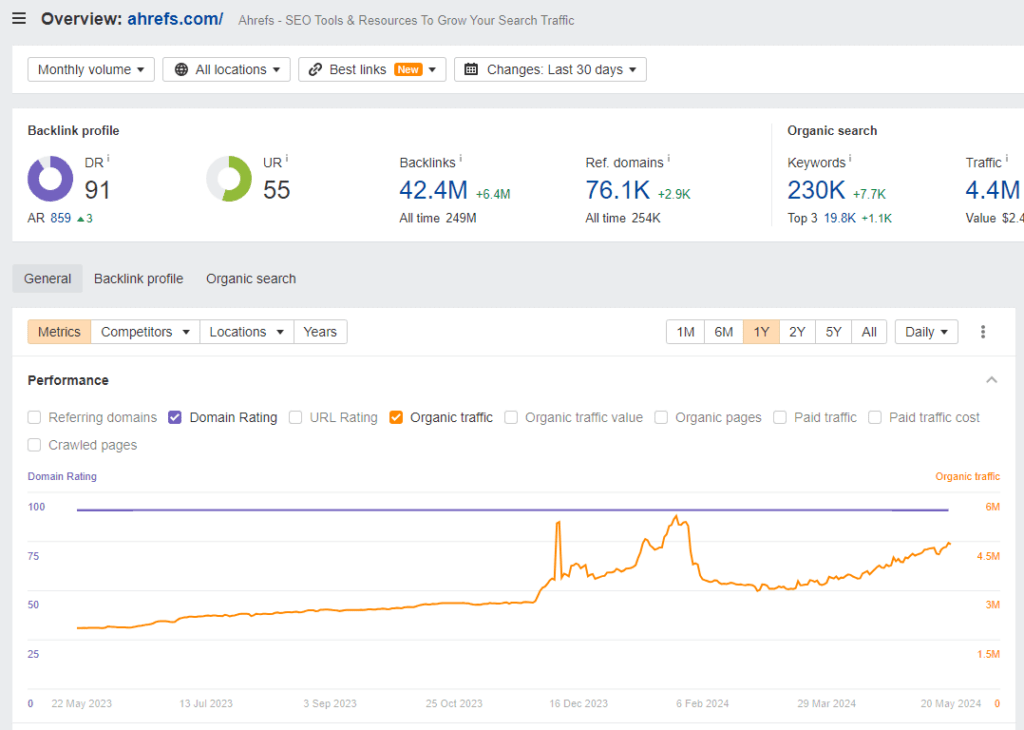
Additionally, they cover every buyer journey stage, from beginner guides to advanced SEO techniques for professionals. Combined with the smart insertion of their tool, the content Ahrefs publishes effectively converts readers into paying customers without a freemium model or free trial.
Conclusion
As you can see from these strategies and examples, SaaS product marketing can extremely influence sales if you do it right. When you find a combination of strategies that works, you will attract, convert, and retain customers and make them refer your product to others.
SaaS product marketing done right will help you achieve sustainable business growth that no other method can even come close to. It’s because you’re not focusing on one channel and implementing one strategy, but you take a holistic approach to marketing a SaaS product that will give you a competitive edge and long-term ROI.
To achieve that, take the following steps:
| Set a solid technical foundation by optimizing your website’s speed and performance for search engines.Support your SEO efforts with valuable content for all SaaS customer journey stages. Create new content for social media and share your existing content with your audience to drive traffic and conversions to the website. Remove the barrier and show the excellence of your product to people who are not ready to commit yet with freemium model and free trials. Convert those people with email marketing and get loyal customers who refer your product to others. |
As you can see, the holistic approach is extremely important. Because of that, your best bet is to hire an all-in-one agency that acts as an extension of your SaaS product marketing team. Besides SEO and content marketing, we’re also a SaaS PPC agency that effectively reduces your CPC (cost per click) while driving the conversions up.
If you want a partner that roots for you and delivers tangible results that positively affect your bottom line, book a call with us and get a free blog post that serves as a testament to our results.
FAQ
Product marketing SaaS involves strategies to promote and sell Software as a Service product by understanding the market, identifying target customers, and implementing campaigns to attract, convert, and retain users, ultimately driving revenue growth.
SaaS products are marketed through content marketing, SEO, social media marketing, email marketing, freemium models, customer testimonials, and webinars, focusing on attracting, engaging, and retaining customers.
SaaS stands for Software as a Service, a model where applications are hosted by a service provider and accessed over the internet, offering flexibility, scalability, and cost savings.
In the United States, SaaS product marketers make $124k on average annually [5] , with higher salaries for senior roles or positions in high-demand markets, often supplemented by bonuses and stock options.
Branding a SaaS product is an important part of SaaS startup marketing, and it involves defining your brand’s mission, creating a unique value proposition, developing a consistent visual identity, and crafting a cohesive brand voice to ensure all communications reflect your brand’s personality and values.
Digital marketing encompasses a broad range of online marketing activities for various industries. In contrast, digital marketing for SaaS specifically focuses on promoting and selling software products delivered over the Internet, often emphasizing user experience, subscription models, and customer retention.
The four product marketing strategies are market penetration (increasing market share in existing markets), market development (expanding into new markets), product development (creating or enhancing products to meet changing needs), and diversification (introducing new products into new markets).
References
- https://www.productmarketingalliance.com/product-marketing-stats/ [1]
- https://uplandsoftware.com/kapost/resources/blog/product-marketing-strategy/ [2]
- https://nulab.com/learn/project-management/95-new-products-fail-heres-succeed/ [3]
- https://pagespeed.web.dev/ [4]
- https://www.glassdoor.com/Salaries/product-marketing-salary-SRCH_KO0,17.htm [5]
